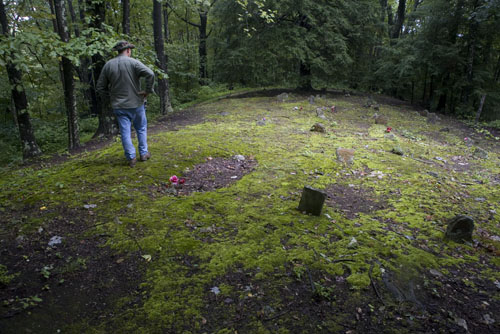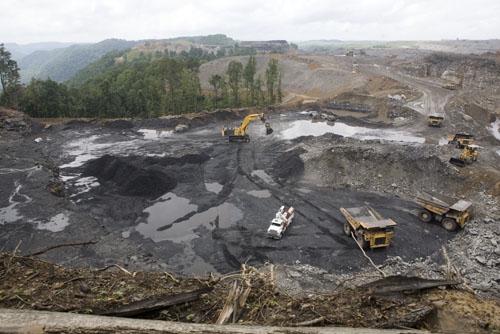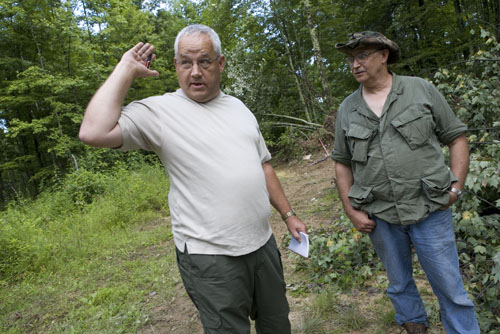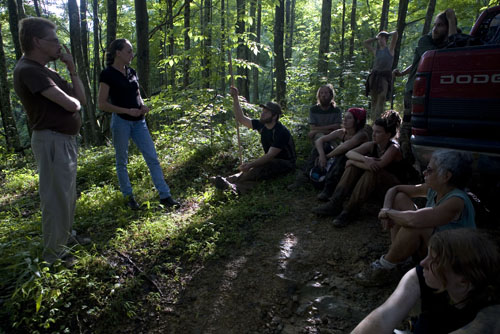FILM REVIEW: The Last Mountain
Film Review: The Last Mountain
by Mike Roselle
Several very good documentaries have been produced over the last decade on the tragic issue of mountaintop removal coal mining in Appalachia. Many of them have focused on the Coal River Valley, and for good reason. This is the heart of coal country, and don’t call it the coalfields, because these mountains and hollows are home to people who have for over a century been sacrificed for those black rocks and some bristle at the term. “The correct term”, says Bo Webb, a local activist and long-term resident, “is sacrifice area.”
“We are being killed for coal.”
Another reason filmmakers are attracted to the area is that Bo and the many people like him that have stood up to the coal industry, extraordinarily courageous people who fight passionately to protect their communities and their way of life. They don’t mince words.
Here on Rock Creek where I have lived for the last three years, it seems we meet a new documentary filmmaker every month or so. They make the rounds to get their story, traveling up to Kayford Mountain to interview Larry Gibson, or visiting the home of Maria Gunnoe, Bo and dozens of other members of the community here on the Coal River. And some very good documentaries have been produced. Michael O’Connell’s, Mountiantop Removal, Francine and Adams Woods’ On Coal River and Mari-Lyn Evans and Phylis Geller’s Coal Country are all films that have introduced many of these local activists to a global audience and alerted many people to what Robert Kennedy Jr has called the worst environmental crime on Earth.
In the process, some of the citizen activists, like Larry Gibson, have become well known personalities in places as far away as Europe and Australia and I’ve become used to seeing my neighbors up on the big screen. The previous films have been very personal and powerful testimony to both the urgency of the issue and the passion and courage of those who have stood up to fight it, and they have educated, inspired and motivated many thousands of people who would otherwise know little or nothing about mountaintop removal.
All this was on my mind last night as I went to an advance preview in Sylvester, West Virginia of The Last Mountain, the new film by director Bill Haney about the campaign to save Coal River Mountain I wondered, “ How will this film be different? ”
It didn’t take too long before the answer to that question became very clear. Bobby Kennedy, Jr. Long before anyone had climbed up on Kayford Mountain to visit Larry, or had met Judy Bonds or Maria Gunnoe, Robert Kennedy Senior had been trying to end strip mining in Appalachia. And, as the film shows, young Robert was concerned about the environment from early on, becoming an activist at the age of 8 and monkey wrenching a housing development by age 11.
Since then he has litigated for clean water as an attorney for Natural Resources Defense Council (NRDC), spent 30 days in jail for protesting the bombing on Vieques Island, off the island of Puerto Rico, by the US Air Force and has represented the Riverkeepers, a large grassroots network that works to clean up our waterways, and authored a New York Times’ bestseller Crimes Against Nature (2004). Over the years he was also a frequent visitor to the Coal River Valley and has been a tireless advocate for the abolition of mountain top removal.
Sundance 2011 – Images by antrim caskey
Photographs from the Sundance 2011 Film Festival in Park City, Utah where The Last Mountain made its world premiere along with 17 other documentaries admitted to this year’s festival.
This beautifully edited film allows us to get to know Kennedy much better, and he helps us get to know Coal River Mountain, and to understand why it is so important. He argues that coal companies like Massey Energy are not only destroying the mountains, they are breaking the law, and that the local politicians look the other way because of the millions of dollars in cash that the coal industry on elections. Of course, many of us know all this, but the The Last Mountain escorts the viewer step by step on how we got here, including West Virginia’s critical support of President George W Bush and the subsequent appointment of J. Steven Griles to the Department of the Interior, a small but important detail that illustrates the treachery unleashed upon us of late.
The Last Mountain not only informs us, The Last Mountain challenges us all to get involved. Robert Kennedy, Jr is drawing a line in the sand and asking us to stand with him as he advocates for non-violent civil disobedience to save Coal River Mountain. The film includes many dramatic scenes from protests by Coal River Mountain Watch, Ohio Valley Environmental Coalition and Climate Ground Zero.
Regular visitors to this site do not need to be reminded of the costs of mountain top removal and the devastation it wreaks. There is no need to quote all of the horrible statistics; 500 mountains destroyed; thousands of miles of creeks buried; two million pounds of explosives detonated each day and so on. Yet even if you already know this, this film puts all that information out in a way that will still make you see Coal River Mountain in a new light. It also takes a larger look at the coal industry, from the processing, shipping, and burning to storing the fly ash and lays out the true costs of using coal to make electricity.
The Last Mountain also examines the alternative to burning coal for electricity, pointing out that wind power could replace all of that electricity as Kennedy takes us on a virtual tour of the proposed Coal River Mountain Wind Farm that over its lifetime would not only produce more electricity cheaper, but provide more tax money to the county than does coal mining.
Seeing Bobby Kennedy’s commitment to saving this last mountain gave me new hope that this battle can still be won. As Bo Webb states in the film, “Coal River Mountain stands as a symbol of what could be, and what the future of America – not just Appalachia – but what the future of America can hold.” Whether you have ever heard of mountain top removal or not, and even if you thought you knew everything about coal mining and the global campaign to stop it, this movie will enrage and astound you with its graphic depiction of the violent devastation of the land and the people of Appalachia.
Hopefully it will also inspire you to join the movement to stop this madness. In this important and beautifully crafted film, director Bill Haney has made a strong case that the destruction of these mountains and these communities is the worst environmental crime in America, and that saving Coal River Mountain is about much more than saving one mountain.
The Last Mountain opens in select theaters June 3, 2011
For more information go to http://thelastmountainmovie.com/film/
Dialogue on Cook Mountain Begins

Dialogue on Cook Mountain Begins
by Antrim Caskey
James Creek, WV — A community service project to clear the access road from James Creek up Cook Mountain to three historic Cook family cemeteries spurred an open dialogue between Horizon Resources, LLC coal workers, the Cook family, community activists and Randall White of the Boone County Sheriff’s Department.
The mountain road that has been used for more than two hundred years to access the grave of William Chapman “Chap” Cook, a Union soldier fighting for freedom with a state that seceded from Virginia to take a stand against slavery — an ancestor the Cooks and families throughout Boone County revere for his bravery.
Sheriff White told the group on Cook Mountain yesterday how he has routinely checked in on Chap’s grave over the years, “I stop by to check on it to make sure no on has messed with it…someone might dig him up to get the gold buttons off his uniform!”
Danny Cook, a direct descendant of the Civil War veteran Chap Cook, discovered a series of road blocks on the road connecting Chap’s grave to two other Cook cemeteries about three weeks ago. The community of James Creek immediately responded to what they saw as a violation of West Virginia law that governs access to family cemeteries in close proximity to coal mining operations.
As news of the blocked road spread through the community, reporters and activists began to visit the site and see for themselves how close Horizon Resources coal mining operations were to the Cook cemeteries. Reports on this website elicited a lot of comments, some less savory than others.
Those who have visited Larry Gibson’s family cemeteries on Kayford Mountain, about an hour south of the state capital Charleston, where Stover cemetery is an island surrounded by miles of moonscape and accessible only through the mine site, can imagine the situation on Cook Mountain. Though on Cook Mountain, the moonscape left by mountaintop removal sprawls from only one side of the mountain ridge tip, where the cemeteries stand. The community worries that the blocked access roads — the Lindytown access road is impassable without a 4-wheel drive vehicle, a skilled driver and the physical ability to scramble over a series of five twelve-foot high roadblocks on foot to reach Chap’s grave — signal that the mining company planned to take the whole ridge and swallow up three historic cemeteries.
In fact, less than two weeks ago, Danny Cook said he spoke to Jeff Sammons, superintendent of the Horizon operation, about the cemeteries and Sammons said that he was not aware of any cemeteries.
But yesterday, we spoke with Jeff Sammons, about one hundred yards from the main Cook cemetery which holds about 27 graves. Clearly, Sammons is aware of the cemeteries now. He complained that “not until we got close did they say anything, but as soon as we got close, Danny Cook and them are screaming about this!”
Perhaps that is the point, the cemetery is directly adjacent to a mountaintop removal blasting zone. This distresses family members.

Sammons swore, “We have no intentions of taking out that cemetery or pushing it over the hill…We’re not Massey! We don’t do that!”
Marvin White, who has kin in the cemeteries on Cook Mountain, remains deeply skeptical, swearing he doesn’t believe a word that mine operator says.

When White’s cousin Randall White, from the Boone County Sheriff department, showed up, Marvin grilled him with questions and secured details of a proposed arrangement to help secure the cemeteries. Randall White vehemently swore that, “Nothing is going to happen to these cemeteries! I live here! I’ve lived here all my life, I’m not going to let anything happen to these cemeteries.”
When he first arrived, the sheriff told a young man helping to drag a pile of sapplings from the road that he was trespassing. White began to mutter about an injunction and $10,000 dollar fines. But when his cousin Marvin White spoke up, the conversation became friendly and open. And it was agreed to that no one was trespassing — Sheriff White understood that the road clearing was a service project dedicated to the Cook family and their historic cemeteries on their homeland.
The volunteers agreed to leave their work as requested by the Sheriff. It was a unique opportunity for dialogue that no one missed.
Randall White promised Marvin White and Danny Cook and the 14 or so people who had come to clear the access road that he’d have deputies stationed at the cemetery road at night and men during the day as well, to make sure the cemeteries were safe.
The second order of business decided upon was to make a measurement and marking of the protective buffer zone around the cemeteries. Randall White, Danny Cook, Marvin White will meet on Saturday, August 1, to mark the boundaries together. Randall White thought he could have his deputies on Cook Mountain in a security rotation as early as Friday evening.
All parties peacefully departed from the conversation. The volunteers who had worked from mid-day to about 5pm clearing three of the 5 muddy roadblocks using shovels, pitch forks, hoes and their hands, walked back towards Chap’s grave, which stands isolated on a spur of the main road, and gathered around the 4-wheel drive vehicles ready to head back down the mountain.
Danny Cook stood before the group in the evening sun that was streaming through the undisturbed forest with tears in his eyes and thanked them for their day of service for Cook Mountain, for the Cook family.

